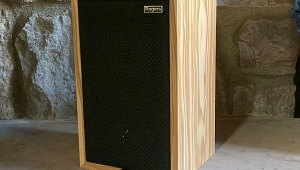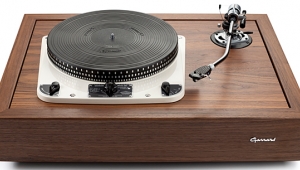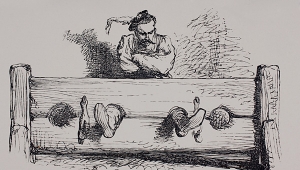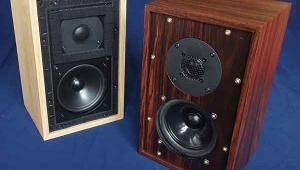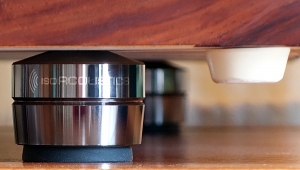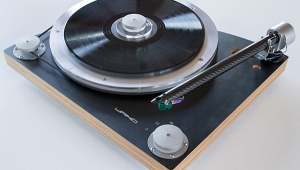| Columns Retired Columns & Blogs |
Listening #78
A new integrated amplifier called the Lars Type 1, which made its debut at the 2009 Consumer Electronics Show, has given my notion of a dichotomy between mainstream audio and alternative audio a severe beating. In that sense, the Lars Type 1 has been a life-changing product, although the change took longer than expected for me to digest.
Footnote 1: E & E Ingenjörsbyrå, Hammarby Fabriksv‰g 23, SE-120 33 Stockholm, Sweden. Web: www.thelars.se.

Designed by Lars Engström and manufactured in Sweden by E & E Ingenjörsbyrå (footnote 1), the Lars Type 1 is supplied in two halves, each of which comprises a single, monophonic integrated amplifier. But they're not identical: One chassis has volume and source-selection controls, the effects of which are communicated to the other chassis via relays and an umbilical. More significant, the Lars Type 1 is a low-power tube amplifier, a category of products for which I admit boundless enthusiasm if not automatic love. It uses a complementary pair of 300B directly heated triodes per channel, for a stated output of 20Wpc into a 4 ohm load. The Lars Type 1 also features transformer coupling between its driver and output stages, and its rail voltage is tube-rectified. To a believer such as I, the Lars Type 1 sounds on paper as if it would sound heavenly.
Indeed, during the five or six weeks I had the review samples in my home, the Lars Type 1 was convincingly, enchantingly musical. It conveyed the dimension of time in recorded music, and the nuances thereof, with uncanny humanness and realism. (In particular, the Lars 1 was the single most rhythmically accomplished tube amp I've ever heard, bar none.) And the Lars sounded good, too: warm and substantial and beautifully textured. On top of all that, the Lars was easily the most visually striking amplifier I've had in my home: It looked like a hundred grand.
Then again, the Lars Type 1 ought to have looked—and sounded—like a hundred grand, because that's how much it costs. Without a phono section. Öy.
Of science
Let's back up for a closer look: The input stage for each channel of the Lars Type 1 is a 6N9P dual-triode tube (think: 6SN7), capacitor-coupled to the driver stage, itself comprising a pair of 6V6S beam-power pentode tubes. The final two plates of that stage are transformer-coupled to the signal grids of the 300B direct-heated triode tubes, sourced from JJ Electronics. Rectification for the B+ rail is supplied by a pair of GZ34 diode tubes.
The basic box of each half-Lars comprises six oblong pieces of sheet metal—four sides, a bottom, and a top—held together with machine screws and lock-nuts. Inside, those surfaces play host to an unusual mix of tube sockets and circuit boards, not to mention Schaffner EMI filters, Philips integrated circuits, and Hahn circuit-board transformers. The huge toroidal power transformers are made by Antrim, and all the rest—coupling transformers, push-pull output transformers, power-supply chokes—are from Lundahl, a name I have come to revere. In a sense, the Lars Type 1 is the most cosmopolitan amplifier I've encountered, with parts from Sweden, the Ukraine, the UK, Germany, France, the Slovak Republic, Japan, China, and the US.
Outside of the box, a series of metal struts support the amp and play host to four nicely cushioned feet—not spikes, thank the Good Lord God. Struts of a similar type are used at the top of the amp to support a thin wood-composite wrap with a rosewood veneer: In photos, the Lars Type 1 seems carved of solid wood, but that impression is dispelled close-up. Also from a distance, the top plate of the amplifier, from which the tubes protrude, appears to be a large, smooth billet of gold-tinted metal, but that's actually a thin cover plate, held to the chassis with four magnets.
In a final aesthetic stroke, the Lars 1 forgoes a metal tube cage in favor of a strikingly different approach: Each chassis is surrounded by four very large and vaguely bracket-shaped panels of Plexiglas that together comprise a transparent protective mantle, as the designer calls it. Each of these beautifully formed panels has a metal disc on its bottommost surface, and is fastened to the amp with a corresponding magnet on each metal base strut.
Some miscellaneous technical notes: Unusually for a low-power amplifier, the output section of the Lars 1 is optimized for a 4-ohm load; designer Engström says that his amplifier can be used with an 8-ohm load, but that it will deliver significantly less than 20Wpc. (Given that the output transformer, a Lundahl LL1620PP, is a stock unit with multiple secondaries, I don't know why alternative taps couldn't be used in order to maximize performance with alternative loudspeakers.) Also, the Lars 1 is said to be a true balanced design, with two of its four line-level inputs configured as XLR jacks.
Now let's move to an altogether thornier question—the hundred-thousand-pound gorilla in the corner, so to speak: Why in the name of all that's good and holy would anyone want to launch a $100,000 integrated amplifier in 2009?
Granted, the Lars Type 1 is attractive; February visitors to my home, male and female alike, were all bowled over. Yet none of them was ever called on to unpack and install the Lars 1, or even to move its two halves just a few feet, from one point on the floor to another. Had they done so, they would have learned in an instant that those top-heavy Plexiglas sides, which I'm sure were frightfully expensive to make, require little more than a strong breeze to come unfastened and topple this way or that: They're no more than decorations, and I doubt they could protect a small child from hot tubes, or vice versa. In fact, the Lars Type 1 was in my system for little more than a day before I became so frustrated with its flimsy sides, and so frustrated with my own inability to combine the words Plexiglas, damn, and whore into sentences capable of amusing both me and my family, that I removed the sides altogether and packed them away until photo day arrived. The Lars 1 sounded no different for the change.
The amp thus denuded, I took a closer look at the top plate—and off it came, too. (It's a pity that the magnets that hold the top plate, and the magnets that hold the Plexiglas sides, are all cemented to the amp itself and not to the removable bits: Otherwise I might have determined whether the presence of all those fields had any effect on the sound.) Finally, I took a closer look at the wood-composite wrap, which looks nice from a distance, and is itself doubtless expensive to make, especially in such (presumably) small quantities. But viewed from up close, the quality of the veneer is not even remotely in keeping with a product that sells for a tenth of a million dollars. Off it came, too.
The finished product looked like a shaved Chihuahua, were Chihuahuas held together with machine screws, and I liked it ten times better than stock. I liked it because it sounded no worse, and because it looked like what it was, not what it was dressed up to be. But most of all I liked it better because now it looked like something I could afford, whether or not that was so.
Of joys and passions
So I relaxed and simply enjoyed the Lars Type 1 for the next few weeks. On the first few selections I thought the amp sounded a little dark, but as the hours and the days wore on I came to think that the Lars 1 was simply allowing my reference Audio Note AN-E/SPe HE speakers to sound like Audio Note AN-E/SPe HE speakers, especially in their mildly dark human-voice range. That said, and in keeping with the majority of high-quality, low-power amps—single-ended triodes (SETs) above all, or so I used to think—the Lars Type 1 sounded magical, and thrilled me with the manner in which it allowed drums, horns, plucked strings, and vocal sibilants and plosives to leap from the soundfield with unusual realism.
But that's not all the Lars had going for it. On Sonny Rollins' take on "I've Grown Accustomed to Her Face," from Rollins Plays for Bird (CD, JVC XR-0055-2), the Type 1 was every inch the classic 300B amplifier, emphasizing, rather uniquely, the richer aspects of Rollins' tone. The amp even had a slightly more realistic combination of timbral richness and reedy texture than my combination of Shindo Masseto preamp and Corton-Charlemagne monoblocks, with less glassiness on the piano, too. And still, the beat carried by Max Roach's foot on the hi-hat pedal was unstoppable, relentless, and completely alive, despite the relaxed tempo.
Footnote 1: E & E Ingenjörsbyrå, Hammarby Fabriksv‰g 23, SE-120 33 Stockholm, Sweden. Web: www.thelars.se.
- Log in or register to post comments


